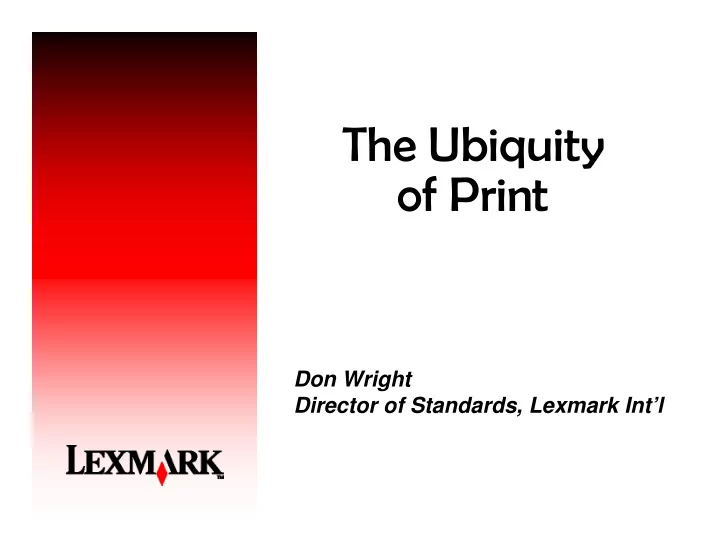

The Ubiquity of Print Don Wright Director of Standards, Lexmark Int’l
Today: Printing and the Web • Printing has increased, not decreased, because of the Web • The seemingly simple idea of printing a web page is, in many cases, impossible – Non-printable content – Text not flowed for paper size – Images not scaled for printing – Bad markup everywhere • To make the Web ubiquitous, we must solve these and other problems. “There will be a paperless office when there is a paperless bathroom.” -- Wall Street Journal, 1985
What does the Ubiquitous Web Mean for Print? • Must the full function of a printing device be exposed? – If not, what subset is necessary? • How should printing devices be modeled? – As a web service? – As a single service or as an amalgam of services? – Is another model necessary for a service which delivers something physical? • Are printing devices modeled as “peers” to web clients, web servers, etc. or as “slaves” ??
Tools in our Belts • XHTML-Print • CSS Profile for Print • Printer Working Group – Internet Printing Protocol – Semantic Model of Printing – Print Services Interface • UPNP Enhanced Print & Bluetooth Basic Printing Profile • Devices Profile for Web Services – WS-Discovery – WS-Eventing – WS-Addressing – WS-Security – others
Problems to be Solved • Discovery • Delivery • Capabilities • Security
Discovery • How are printers discovered? – Broadcasts? – Directories? • Which printers are “in range” in a ubiquitous web? – How can we distinguish “this” printer from “that” printer? • Is selection by sub-net appropriate or sufficient? • Is geographic positioning information needed?
Delivery • How is the print job delivered to the device? – Is it negotiated or mandated? – If it is mandated, should it be IPP or SOAP or HTTP PUT or something new? • Must the sender fully understand the capabilities of the device or are other solutions (e.g., XHTML-Print) sufficient? • Are intermediate services needed (or supported) to transform content into a form usable by a specific printing device? • If intermediate services are supported how do they bind to devices? – How do clients bind to the intermediate services?
Capabilities • Are the attributes & value of the PWG Semantic Model sufficient or is a more complete negotiated capabilities model needed? • How are those device capabilities delivered to the client seeking to use that device? – What protocol? – What format? • Is the management of the capabilities and configuration of these devices appropriate for consideration as a part of this project?
Security • Is the content being printed secured from interception? From alteration? – If so, how? • Does the client or the printer determine if and when security is needed? • What security is needed for the printing device itself to protect it from “print spam” and other attacks? • How is trust established between the client and the printer? – How does the user know that the printer seen on the ubiquitous web is the printer it claims to be?
Path Forward 1. Develop specific use cases and needs for each of the various types of non-computer device classes (e.g., printers, cameras, scanners, and refrigerators). 2. Examine in detail the architectures and models of similar or related efforts (e.g., UPnP) that have already been created. Understand their strengths and weaknesses. 3. Develop the overarching model or architecture for non- computer devices for all classes for the ubiquitous web. Re-use existing technology when possible. 4. Based on the architecture developed above, specific standards (or recommendations) must be developed to address the specific issues and needs of the use cases for each of the device classes.
Thanks!! QUESTIONS?
Recommend
More recommend